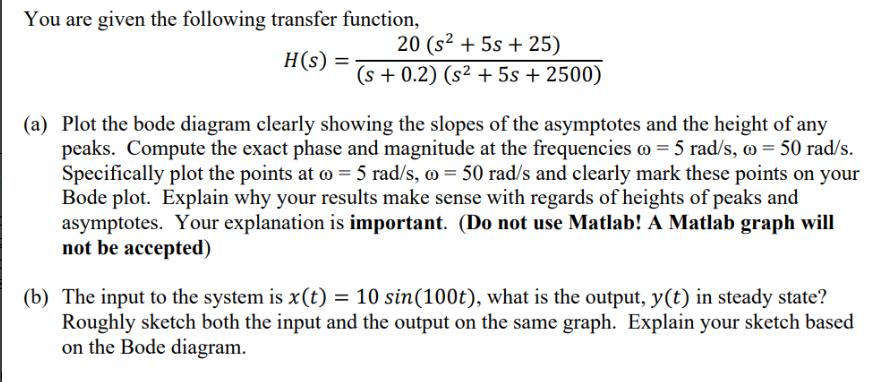Answered step by step
Verified Expert Solution
Question
1 Approved Answer
You are given the following transfer function, H(s) = 20 (s + 5s + 25) (s + 0.2) (s + 5s + 2500) (a)

You are given the following transfer function, H(s) = 20 (s + 5s + 25) (s + 0.2) (s + 5s + 2500) (a) Plot the bode diagram clearly showing the slopes of the asymptotes and the height of any peaks. Compute the exact phase and magnitude at the frequencies o = 5 rad/s, co= 50 rad/s. Specifically plot the points at co = 5 rad/s, o = 50 rad/s and clearly mark these points on your Bode plot. Explain why your results make sense with regards of heights of peaks and asymptotes. Your explanation is important. (Do not use Matlab! A Matlab graph will not be accepted) (b) The input to the system is x(t) = 10 sin(100t), what is the output, y(t) in steady state? Roughly sketch both the input and the output on the same graph. Explain your sketch based on the Bode diagram.
Step by Step Solution
★★★★★
3.40 Rating (153 Votes )
There are 3 Steps involved in it
Step: 1
Steps to Analyze the Bode Plot of the Transfer Function Factor the Transfer Function The numerator can be factored as a constant term times a squared ...
Get Instant Access to Expert-Tailored Solutions
See step-by-step solutions with expert insights and AI powered tools for academic success
Step: 2

Step: 3

Ace Your Homework with AI
Get the answers you need in no time with our AI-driven, step-by-step assistance
Get Started


